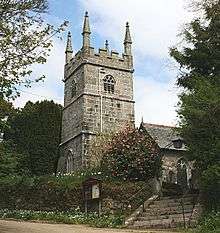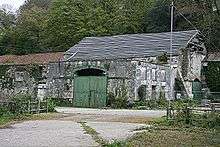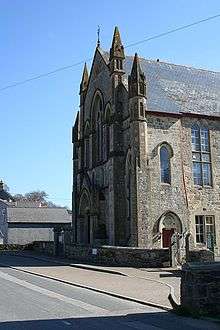Perranarworthal
Coordinates: 50°12′29″N 5°07′08″W / 50.208°N 5.119°W




Perranarworthal (Cornish: Peran ar Wodhel)[1] is a civil parish and village in Cornwall, England, United Kingdom. The village is about four miles (6.5 km) northwest of Falmouth and five miles (8 km) southwest of Truro.[2] Perranarworthal parish is bordered on the north by Kea parish, on the east by Restronguet Creek and Mylor parish, on the south by St Gluvias and Stithians parishes and on the west by Gwennap parish. The parish population at the 2011 census was 1,496.[3] The name derives from the Manor of Arworthal which has had a number of spellings in the past including Hareworthal (1187), Arwoethel and Arwythel. By the 18th-century two names appear on maps "Perran Arworthal" meaning St Piran's by the creek or estuary. William Penaluna described the settlement in 1838.[4]
Perran Wharf is the area of the parish beside the River Kennall (a tributary of Restronguet Creek) where there were wharves and a quay. This is currently being developed into Perran Foundry where there will be new homes and working space settled amidst the history of the site. The other settlements in the parish are Perranwell and Perranwell Station.
Historic foundry
It was the home of the Perran Iron Foundry,[5] an innovative concern, run by the Fox family of Falmouth and other Quaker business families. It was set up on the site of a tin smelting works in 1791. The foundry was later operated in partnership with the Williams family, and in 1858, it was sold to them.
The creek serving the factory silted up and mining in Cornwall declined. The wharf had been used to import timber for the mining industry from Scandinavia. The slump in the mining industry during the 1870s hit Perran Foundry badly and it closed in March 1879 with the loss of 400 jobs, causing great distress in the parish. In April 1879, the Royal Cornwall Gazette reported that a soup kitchen had been open since January: ″793 people had attended and 1,240 quarts of soup were distributed″.
The buildings including Manor Mill on the opposite side of the road were later adapted by the Edwards Brothers for the milling and storage of grains and animal foods, and also cloth dyeing; another waterwheel was added. Over the years there have been ambitious plans which have come and gone, but little changed at the foundry site for many years apart from the gradual deterioration of the buildings.[6] The site has been used for various purposes since but closed in 1986.
In 2005, the owners, North Hill Estates Ltd., applied for planning permission to redevelop the site. The proposal was for a mix of live/work units and residential accommodation. Further consultation on their proposal was ongoing (2007).[7][8][9]
Planning was approved and the site has been under development in recent years to enable new homes to flourish from the foundations of its 200-year history.[10] One of the site's most iconic buildings is The Hammer Mill where all of the workings took place. This will be the first opportunity for people to acquire a home in this historic setting, as the show home opens for private viewings on 24 June 2013 with Heather & Lay and Savills.
Notable buildings
Perran Foundry is being revived by North Hill Estates Ltd with sensitive renovation and regeneration, acknowledging its immense value to Cornish history.[11]
The Hammer Mill is the most iconic building on this site, converted from what was originally the heart of the old foundry, to provide seven unique houses with up to four bedrooms over three floors. With the past complementing the contemporary, it blends modern comforts including double glazed facades, balconies and under-floor heating with character and charm, such as exposed walls, feature windows and original trusses. The lofts, apartments and riverside homes being developed at the Perran Foundry commemorate the building's iconic past, as each building has adopted its name from its original purpose.[12]
The Norway Inn[13] was known originally as the Norway Hotel and the name derives from the Norwegian vessels which once brought loads of timber to Perran Wharf,[14] largely for use in the mines. The timber would be seasoned by being 'pickled' for several months in shallow tidal ponds. The Norway Inn was built in 1828/1829 at the same time that the main Falmouth to Truro road was rerouted to cross the Carnon River on an embankment just above the village of Devoran.[15] As of 1 December 2011 the Inn, after having had a refurbishment, is offering accommodation in four of its rooms.
Tullimaar House, an early 19th-century mansion, is in the parish. It was the home of Nobel Prize-winning novelist Sir William Golding and is still occupied by Golding's son David.
Religious buildings
The 15th-century Anglican parish church dedicated to Saint Piran was rebuilt to the design of James Piers St Aubyn in 1884. The original granite tower remains from the 15th-century church. Pevsner described the church as "indifferent".[16] The foundation stone of the Wesleyan chapel was laid on 17 March 1879 and the first service was held on Thursday, 5 February 1880. The chapel, designed by James Hicks of Redruth is built in the early English style at an estimated cost of £2,220 and can accommodate six-hundred people.[17]
Notable people
Notable people from Perranarworthal include Charles Fox (scientist) and Barclay Fox, managers of the Perran Foundry; Saint Piran[18] or Perran after whom Perran Foundry was named; the poet Jane Crewdson, née Fox, was born here; William Jory Henwood, mining geologist who was born at Perran Wharf; William Lobb (1809–1864), a plant collector who was responsible for the commercial introduction to England of the "monkey puzzle" tree Araucaria araucana and the Sequoiadendron giganteum.[19] William Golding, the novelist, died here in 1993 having lived in the village for the last 8 years of his life
References
- ↑ Place-names in the Standard Written Form (SWF) : List of place-names agreed by the MAGA Signage Panel. Cornish Language Partnership.
- ↑ Ordnance Survey: Landranger map sheet 204 Truro & Falmouth ISBN 978-0-319-23149-4
- ↑ "2011 census.Retrieved 8 Feb 2015".
- ↑ An Historical Survey of the County of Cornwall, Etc.: In Two Volumes By W. Penaluna Volume 2, pages 157–158. Google Books – Harvard copy, formerly owned by Davies Gilbert
- ↑ Cornish Mining History website article on Perran Foundry and Cornwall Industrial Settlements Initiative Report: Perranarworthal
- ↑ Barton, D. Bradford (1968). The Cornish Beam Engine (2nd ed.). Truro, Cornwall: D. Bradford Barton. pp. 152–159.
- ↑ "Further consultation on foundry scheme" article by Melanie Jago in The West Briton 12 July 2007, page 33.
- ↑ Carrick District Council Planning Application PA16/2574/05/M
- ↑ West Briton 27 September 2007, page 30 "Foundry go-ahead".
- ↑ Western Morning News 25.5.13
- ↑ Cornwall Property Paper June 2013
- ↑ Perran Foundry website www.perranfoundry.com
- ↑ Norway Inn website
- ↑ Perran Wharf photographs
- ↑ The Village of Devoran
- ↑ Pevsner, N. (1970) Cornwall; 2nd ed. Penguin Books; p. 139
- ↑ "Perranwell Wesleyan Chapel Opening Services". The Cornishman (83). 12 February 1880. p. 7.
- ↑ Saint Pirran from Wikipedia 17.6.13
- ↑ Hawkes, John G. "William Lobb in Ecuador and the Enigma of Solanum lobbianum". 41: 471–475. JSTOR 1222817.
- General
Further reading
- Acton, Bob Exploring Cornwall's tramway trails, Volume 2: The coast-to coast trail: Portreath to Devoran and beyond, Penpol, Landmark Publications (1997) ISBN 1-873443-28-5
- Perran Foundry website www.PerranFoundry.com
External links
| Wikimedia Commons has media related to Perranarworthal. |
- Cahill Partnership & Historic Environment Service, Environment and Heritage, Planning, Transportation and Estates, Cornwall County Council Cornwall Industrial Settlements Initiative; Perranarworthal (Truro area) 2005 Perran Foundry Heather & Lay Savills